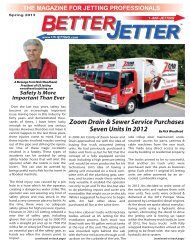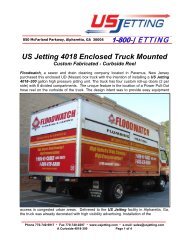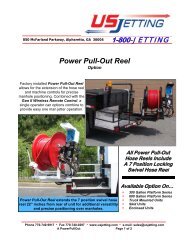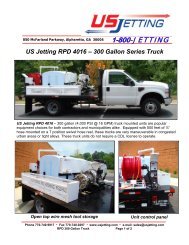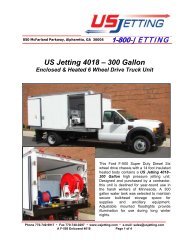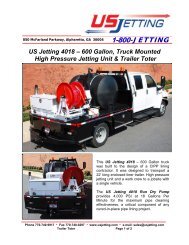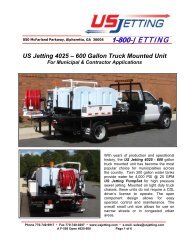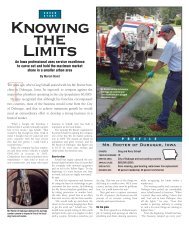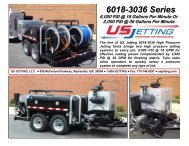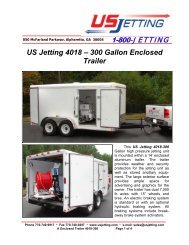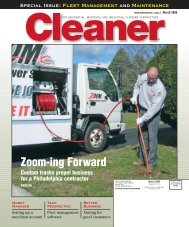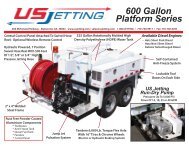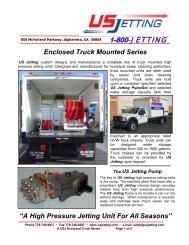Nick Woodhead - US Jetting
Nick Woodhead - US Jetting
Nick Woodhead - US Jetting
You also want an ePaper? Increase the reach of your titles
YUMPU automatically turns print PDFs into web optimized ePapers that Google loves.
On a Mission<br />
<strong>Nick</strong> <strong>Woodhead</strong> helped bring waterjetting to the<br />
United States and supported its development<br />
with two major manufacturers<br />
nick <strong>Woodhead</strong> first saw a waterjetter while<br />
working as a service contractor in England<br />
in the early 1970s.<br />
Around that time, a new national law<br />
required trucks to be cleaned before mandatory safety<br />
inspections. A market quickly grew for pressure washers,<br />
and it wasn’t long before inventors figured out that<br />
somewhat larger machines, if equipped with nozzles,<br />
could be used to clean pipes.<br />
Those early jetters delivered 2,500 psi at 10 gallons per<br />
minute (gpm). The company <strong>Nick</strong> worked for bought<br />
its first jetter in 1973, then a second, then a third. By<br />
1975, the units were delivering 4,000 psi/10 gpm.<br />
Jetters quickly caught on in<br />
England, but when <strong>Nick</strong> came<br />
to the pipe cleaning industry<br />
in the United States in 1981,<br />
he found the market still<br />
largely wedded to cable and<br />
rodding machines and skeptical<br />
of the new technology.<br />
Over more than two decades<br />
since, he has been among the<br />
leaders in bringing waterjet<br />
technology to the forefront,<br />
first with Harben Inc. and then,<br />
since 1991, as co-founder of<br />
<strong>US</strong> <strong>Jetting</strong> LLC.<br />
A step forward<br />
<strong>Nick</strong>, son of a British cotton<br />
classifier, was born in Egypt<br />
and lived there until the Suez crisis in 1956. He lived for<br />
a time in Peru before his father returned to England.<br />
There, <strong>Nick</strong> completed his schooling and went to work<br />
in advertising in London before getting involved in the<br />
contracting business. He joined Harben in that country<br />
as the first salesman other than the sales director John<br />
Twigg, and worked there until August 1978.<br />
At that point he joined a small division of the<br />
By Ted J. Rulseh<br />
“The concept of reducing the<br />
amount of water and raising the<br />
pressure achieved two objectives.<br />
One, you could make the<br />
machine smaller and more<br />
affordable. And two, it didn’t use<br />
as much water so it didn’t need a<br />
huge tank. The advantages made<br />
the jetter a tool that a plumber<br />
could afford to buy and could<br />
make money with.”<br />
<strong>Nick</strong> <strong>Woodhead</strong><br />
Saluting Industry Pioneers<br />
Guinness brewing company that made injection-molded<br />
sailboats, and came to the United States in February<br />
1979 to set up sales and distribution. <strong>Nick</strong> knew he<br />
wanted to work in the States and just needed something<br />
to get him there. In 1981, Harben brought him back<br />
on board to help start a United States operation,<br />
Harben Inc.<br />
<strong>Nick</strong> was already a believer in jetting. “The whole<br />
concept of high pressure and low volume is that you<br />
use less water to do more work,” he said. “The speed of<br />
the water coming out of the nozzle does the cleaning.<br />
“In old days, people were using 20 to 36 gpm at<br />
1,200 to 2,000 psi. That was a standard trailer jet in<br />
those days. Those machines<br />
were what we called flushers. We<br />
turned up on the scene with a<br />
high-pressure jet. It allowed us<br />
to use 1/2-inch hose, which was<br />
lightweight and easy to use and<br />
would go 500 feet up a pipe in<br />
nothing flat, plus we could use<br />
1/4-inch hoses as well for even<br />
smaller lines.<br />
“The concept of reducing the<br />
amount of water and raising<br />
the pressure achieved two<br />
objectives. One, you could make<br />
the machine smaller and more<br />
affordable. And two, it didn’t use<br />
as much water, so it didn’t need<br />
a huge tank. The advantages made<br />
the jetter a tool that a plumber<br />
could afford to buy and could make money with.”<br />
Steady evolution<br />
In his contracting days, the machines <strong>Nick</strong> used<br />
were small trailer-mounted units with 20 hp Petter<br />
diesel engines and no water tank. “We would put a cattle<br />
trough in back of a pickup and would have a suction<br />
hose with a filter coming off the pump,” <strong>Nick</strong> said.<br />
This is another in a series of profiles of Industry Pioneers that will be published in Cleaner leading up to the 25th<br />
Annual Pumper & Cleaner Expo in February 2005. Readers are welcome to recommend outstanding industry contributors<br />
for profiles in future editions. Send your suggestions to Jeff Bruss by e-mail (jeffb@pumper.com), fax (715/546-3786) or mail<br />
(COLE Publishing, P.O. Box 220, Three Lakes, WI 54562).<br />
P R O F I L E<br />
<strong>Nick</strong> <strong>Woodhead</strong><br />
YEARS IN THE IND<strong>US</strong>TRY: 30<br />
COMPANIES:<br />
Harben Inc. and <strong>US</strong> <strong>Jetting</strong> LLC<br />
UNIQUE CONTRIBUTION: Promoting and developing the<br />
concept of high-pressure,<br />
low-volume waterjet pipe<br />
cleaning in the United States<br />
“We’d fill the trough with water, throw the filter in<br />
there, and try to prime the pump. We had a little reel<br />
on it with about 300 feet of hose. The diesel engines<br />
had to be hand-cranked, which was a real problem in<br />
cold weather.<br />
“We found these machines were very effective for<br />
commercial drain cleaning — much easier than using<br />
rods or cables. The only non-mechanical alternatives in<br />
the UK were large, truck-mounted units that were out<br />
of the average contractor’s price range.”<br />
Harben Inc. started with jetters that carried a 35-<br />
gallon water tank, manual reel, and 30 hp Lister diesel.<br />
“Over here, there was a lot of resistance,” <strong>Nick</strong> recalled.<br />
“Contractors said, ‘We’ve been using cable machines<br />
for the past 20 years. Why should we change?’ I said,<br />
‘Because someone’s going to jump on this, and the rest<br />
of you are going to be left behind.’ It was difficult in the<br />
early years because there were no reference customers.”<br />
<strong>Nick</strong> started with Harben Inc. in California, setting<br />
up distributors. He sold his first machine to Bruce<br />
Williams, owner of a Rescue Rooter franchise in<br />
Hayward, and his second to Skip Stewart of Stewart<br />
Plumbing and De-Rooting in Santa Barbara. “Bruce<br />
Williams convinced a lot of other Rescue Rooter franchisees<br />
to buy them, and then the Rescue Rooter<br />
Corporation took notice,” said <strong>Nick</strong>. “Things started to<br />
take off on the West Coast.”<br />
A big break<br />
He later moved to Atlanta to set up the factory and<br />
also began attracting dealers and selling units to the<br />
East Coast. One of his first customers was a Roto-Rooter<br />
store in Stratford, Conn., run by Tom Conway and<br />
Jim Gura.<br />
“Roto-Rooter had just been purchased by Chemed,”<br />
said <strong>Nick</strong>. “We went to Stratford to do a demonstration<br />
for the company-owned Roto-Rooter locations in the
“Our whole idea is: Let’s make it a win-win. We don’t look at our customers<br />
as customers. We look at them as part of our team. It’s a joint effort. If our<br />
customers are successful, then we will be successful. Our philosophy is that<br />
if we don’t sell you a second unit, we haven’t done our job.”<br />
<strong>Nick</strong> <strong>Woodhead</strong><br />
<strong>Nick</strong> <strong>Woodhead</strong> with the first<br />
jetter model manufactured<br />
by <strong>US</strong> <strong>Jetting</strong>.<br />
could run out of water without damage. A plunger<br />
pump is easier to maintain and has only six valves as<br />
compared to 16 with a comparable diaphragm pump.<br />
For the same size, a plunger pump produces considerably<br />
higher volume.”<br />
The <strong>US</strong> <strong>Jetting</strong> team diligently went to work building<br />
a customer base. “We made ourselves easy to do business<br />
with,” <strong>Nick</strong> said. “Our whole idea is: Let’s make it<br />
a win-win. We don’t look at our customers as customers.<br />
We look at them as part of our team. It’s a joint<br />
effort. If our customers are successful, then we will be<br />
successful. Our philosophy is that if we don’t sell you a<br />
second unit, we haven’t done our job properly.”<br />
<strong>Nick</strong> and his <strong>US</strong> <strong>Jetting</strong> colleagues operated on the<br />
premise that the optimum waterjetter performance is<br />
achieved at 4,000 psi and 16 to 18 gpm. Among their<br />
other innovations is the wireless remote control, and<br />
power pull-out swivel reels, which have been on the<br />
market for the past two years.<br />
The company has seen jetting expand from the commercial<br />
contractor market into the municipal and industrial<br />
sector. Trailer-mounted and small truck-mounted<br />
jetters have proven more cost-effective than large combination<br />
trucks for clearing blockages in 4- to 12-inch<br />
lines. Cities that own jetters can reserve their larger<br />
equipment for routine maintenance and for big jobs,<br />
<strong>Nick</strong> observed.<br />
Northeast. All the managers came to Stratford to look<br />
at our machine. At the end of the meeting, they came<br />
out and said, ‘Thanks, but no thanks.’ It was very<br />
disappointing.<br />
“They just didn’t think it was something that would<br />
work for them. It was too small. The first machine had<br />
a manual reel, and they said nobody in this country was<br />
going to pull hose by hand. We had a powered reel on<br />
the unit in about a week.<br />
“Soon after that, I cut a deal with Conway and Gura.<br />
I told them that if they got a job in next month that they<br />
couldn’t handle with a cable machine, I would bring the<br />
jetter up and loan it to them, and if it did the job, they<br />
would buy one.<br />
“They called in a week. They had a contract at a GE<br />
plant to clean overhead pipes. Their practice had been<br />
to dismantle the pipes and use a cable, and it took from<br />
three to five days to do it. They thought this was an<br />
ideal opportunity for the jet. I took the unit to them.<br />
They did the job in a day without dismantling hardly<br />
any pipes and charged the same amount. That was our<br />
first sale to Roto-Rooter.”<br />
Gura then transferred to the Houston area and<br />
soon bought a machine there. “Then it started to mushroom,”<br />
<strong>Nick</strong> recalled.<br />
A new company<br />
In 1987, British Fittings, a public company, bought<br />
Harben in England and the <strong>US</strong>. Four years later, <strong>Nick</strong><br />
left with a colleague, Ken Bryson. They teamed up with<br />
former Harben Systems founder Allan Bennie and<br />
another investor to launch <strong>US</strong> <strong>Jetting</strong>.<br />
“Harben had a unique product with a radial piston<br />
diaphragm pump,” <strong>Nick</strong> said. One of its advantages was<br />
that it was able to run out of water without damage.<br />
“At <strong>US</strong> <strong>Jetting</strong>, we designed a plunger pump that also<br />
Need new blood<br />
The entire waterjetter sector has expanded greatly<br />
since <strong>Nick</strong> entered the United States market in the early<br />
80s. “Since I started, four or five other manufacturers<br />
have come on-line,” he said.<br />
He sees the business growing dramatically over the<br />
next ten years on the manufacturing and contracting<br />
sides alike. “I would like to get more young people<br />
involved in the industry,” <strong>Nick</strong> said. “I don’t see as<br />
many young people coming into the business on the<br />
manufacturing side.<br />
“It’s an exciting industry. It’s challenging. It changes<br />
every day, and we actually do something positive. When<br />
you see one of our machines working, you see that it<br />
actually does good for the community.<br />
“Plus, the guys can make an excellent living using<br />
them. I’ve had a lot of contractors who have said to me,<br />
‘Without you forcing us to buy one of these machines,<br />
we would never be where we are today.’ Some of these<br />
guys have become very successful, and very wealthy<br />
businessmen because they bought a jet in the early days.<br />
“And we still haven’t scratched the surface,” says<br />
<strong>Nick</strong>. “There are more opportunities today than in the<br />
early days, because many more people are aware of what<br />
a jet can do.” ■<br />
© 2004, COLE Publishing Inc.<br />
Reprinted with permission from Cleaner, June 2004 / COLE Publishing Inc., P.O. Box 220, Three Lakes, WI 54562 / 800-257-7222 / www.cleaner.com



